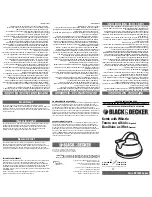
STEAM
All steam plumbing to and from the kettle and steam boiler should be thoroughly cleaned and
inspected for dirt and debris before final connection to the kettle are made.
Generally, kettles require 1/2" i.p.s. pipe, 10-45 psi steam pressure. If the steam supply pressure
exceeds 45 psi, a pressure reducing valve is required. The steam inlet is at the right side of the
kettle, as seen from the front.
A pressure reducing valve is required on the incoming line as shown below. The relief valve
should have a capacity of 300 lb/hr (136 kg/hr).
CONDENSATE (Kettles without SD Stands)
Maximum pressure rating on table-top kettles is 50psi. It is highly recommended that a pressure
relief valve equal to or less than this pressure be installed on the incoming steam line close to the
kettle.
A steam condensate trap must be plumbed to a drain, using minimum 1/2" NPT plumbing. The
condensate line is limited to a maximum rise of 10 feet in order for the steam pressure to
adequately force the condensate through the plumbing. Any higher rise requires a pump.
If the steam boiler to which this kettle is installed has a condensate return (closed loop system), a
1/2" steam strainer, a 1/2" steam trap, and a 1/2" check valve must be installed on the output
(condensate) side of the kettle.
CONDENSATE (Kettles c/w SD Stands)
The stand comes factory plumbed so the condensate is connected to the stands drain manifold.
RECOMMENDED PIPING SCHEMATICS
(all service connections shown supplied by others)
1
STEAM IN
2
TO DRAIN OR BOILER CONDENSATE LINE
3
TO DRAIN (CONDENSATE RETURN PLUMBED TO
1 1/2" DRAIN MANIFOLD)
A
UNION
B
CHECK VALVE
C
STEAM TRAP
D
STRAINER
E
PRESSURE REDUCING VALVE
F
SHUT OFF VALVE
G
RELIEF VALVE
United Kingdom




































